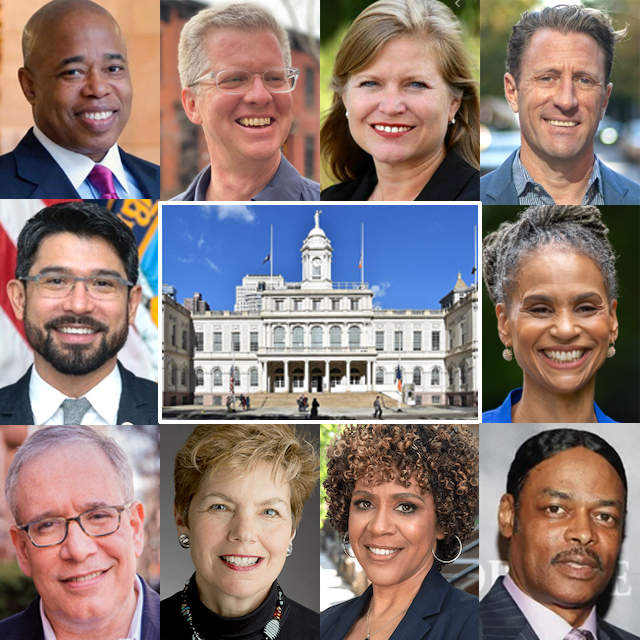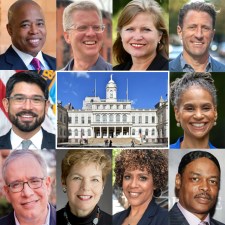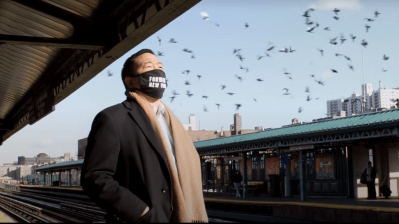DECISION 2021: Which Mayoral Candidates Support a Car-Free Manhattan?
Some hizzoner hopefuls are surprisingly open to some version of the idea, Streetsblog's questionnaire found.


One day, with hope during our lifetimes, private cars will be banned from use in Manhattan south of a certain point (let’s go big and say 125th Street), a proposal that has already gained traction with a raft of urbanists.
So what do those who would be New York’s next mayor have to say about the idea? Streetsblog asked 11 Democratic mayoral candidates (all except Ray McGuire responded) what they thought about the proposal as part of our candidate questionnaire — and discovered that some are surprisingly open to some version of the idea.
This is the third of daily rollouts of the candidates’ thoughtful and often-voluminous answers, which should provide safe-streets activists with a roadmap of where the hopefuls stand on our issues (the previous two installments focused on safe streets and “free” parking). At the end of the series, we’ll post all seven installments in one place for easy reference.
Here’s today’s question:
Do you support a ban on private cars in Manhattan — and if not, why not?
Here is what they said:

This includes a greater number of busways across the city, expansion of open streets to underserved communities and the creation of bicycle superhighways in every borough. We must provide transportation and safe street infrastructure in every community, not just Manhattan.
This line left intentionally blank for spacing.
This line left intentionally blank for spacing.

From an equity standpoint, residents with disabilities still often require the use of vehicles with assistive devices, and the MTA needs congestion pricing revenue from private vehicles. Meanwhile, I’ve looked at data from the Tri-State Transportation Campaign that shows that many residents in Upper Manhattan still rely on cars to travel outside of the borough. It is also worth noting that many of the city’s leading transit advocacy organizations do not advance the goal of a car-free Manhattan and I share many of those organizations’ goals, which are rooted in the desire for an equitable transportation system for all New Yorkers.
I do believe, however, that existing and future programs will help to significantly reduce car traffic in Manhattan by incentivizing transit use and prioritizing all users of our streets. These are worthwhile goals and my administration would pursue them. Specifically, my administration would pursue three primary policy areas to dramatically reduce reliance on cars in Manhattan and across the city:
Implement congestion pricing: by fully implementing congestion pricing below 60th Street, we will disincentivize unnecessary car trips, reduce the gridlock that costs New Yorkers $20 billion annually, and fund mass transit. My administration will vocally support congestion pricing and work with the state and federal government to implement it as soon as technically feasible.
More and better bus and bike infrastructure: working closely with the MTA, my Department of Transportation would dramatically scale up the deployment of bus lanes and bike lanes, ensuring our streets are shared streets that are safe and equally friendly to transit users, bicyclists and micromobility users, pedestrians, and cars.
Rethink the curb: by re-imagining how we allocate curb space, we can make our streets more fair, less congested, and far more efficient. This means exploring metering parking, creating more delivery and loading zones, and deploying infrastructure for clean transportation so more drivers and fleets are encouraged to make the leap to electric vehicles. And, at every turn, we need to embrace technology that offers the city 21st century solutions.

With my Complete Streets proposal, as we repurpose streets to prioritize public transportation, cycling, and pedestrian safety, we will make the city safer. We will speed up our buses by creating new dedicated busways and bus lanes, expanding off-board payment and all-door boarding, giving our buses priority at intersections, and growing the Express Bus network and Select Bus Service to cut down commuting times. We will expand the protected bike lane network by 250 miles, and better maintain the bike lanes we already have.
We will better integrate Citi Bike into the existing transit network, and subsidize expansion into communities that have been underserved by the existing program. As we create a more integrated infrastructure that makes it more appealing to New Yorkers to skip having a car, we can eliminate the factors that suggest a need to ban private cars. We must keep New Yorkers with mobility issues in mind as we design a comprehensive strategy for all of us to get around.

Many people that have never commuted by car are now doing so out of concern for their and their fellow New Yorkers’ health. In particular, the elderly and immunocompromised. We should not force these people onto public transit before they feel comfortable doing so.
That said, as we consider congestion pricing and how we further reduce reliance on automobiles across the city, there are areas where the adage “never let a crisis go to waste” apply when it comes to the city’s streets: outdoor dining, converting some of our most foot-trafficked spaces below 96th Street into car-free zones, and increasing the pricing for metered parking in the most trafficked areas.
RAY McGUIRE: Did not answer.

I believe that we must reduce traffic in Manhattan (in all boroughs) as quickly as possible and can make an immediate impact by implementing congestion pricing and metered parking, creating a safe bicycle network (including all city bridges), and investing in our public transit infrastructure overall. We need to stop thinking with a car-centric mentality and create more pedestrian only spaces and streets.
A way to propel us into a car free city also includes making it safer beyond building the bike network. We need more cost-friendly solutions like the leading pedestrian interval law that was born from watching safer cyclist culture emerge on our streets. The faster the city can reward safer use of our streets by codifying it into law, the faster we can see more cyclists riding longer distances.

Since Robert Moses, our city has been carved, scarred and segregated to make way for roads, highways and parkways, reorganizing how we live. Areas of the city with higher density of the working and middle class tend to have more drivers — especially those who rely on driving to earn a living. There’s also a strong correlation between these communities and poor/limits access to the subway and transit hubs. Just like most developments in the country, these were designed — to our detriment — as places where people would drive. Those challenges must be addressed, at a structural level, with better ways to get around, without further burdening poor, working and middle class families and communities.
Nearly 80 percent of Manhattanites don’t have a personal car, some of the lowest rates of any large city in this country, because the existing public transportation, flawed as it is, offers a more reliable, inexpensive and/or safe option than driving for most people. The focus should be on the best possible design for a system to move people in the safest, fastest and least-expensive way — and this needs to happen at a scale that Moses could not have dreamed.
A hugely substantial number of the private cars in Manhattan are commuters from outside the city. To that end, it is in the interest of vehicle mitigation to expand regional rail and busses, including the subway NJT, LIRR, Metro North, and so on. That takes time, likely federal money, and obviously crosses lots municipal and jurisdictional boundaries beyond the mayor’s control — but it’s still worth fighting for.

I look at Barcelona, Paris, Copenhagen, and Utrecht and I like what I see.
In my administration, we’re going to look to cities around the world for inspiration, we’re going to learn from them, and we’re going to surpass them.
This line left intentionally blank for spacing.
This line left intentionally blank for spacing.

Long-term, we must adapt our current disjointed transit reality and apply a systems perspective oriented to developing a transit and public space grid that is safe, affordable, accessible, carbon-responsible and oriented to “other than private car” modes of transportation.
In addition to accommodating the myriad passenger transit options, this holistic approach must also incorporate timing and routes for delivery vehicles, recycling and trash pick-up and processing as well as level-setting citywide bridge and tunnel tolls and implementing congestion pricing in a fair and equitable manner, e.g., commuter vehicles cannot be parked above 60th Street to avoid congestion pricing, individuals must be able to access health-care appointments, etc.

Making the decision to restrict private cars in Manhattan, without also making deep investments to improve and make alternatives fully accessible and equitable, could have serious unintended consequences on many communities including folks with disabilities, people of color, working families, and many other people for whom a private car is the safest, most affordable, and most convenient for transportation needs. I will focus on creating a 22nd century public transit system and include conversations with directly impacted communities through People’s Assemblies and other engagement mechanisms so that those typically underserved have a voice in mapping out our transit future. This will inform a discussion on limiting cars in Manhattan and identify where and how we can most directly change how we make meaningful changes that get all our residents where they need to go safely, efficiently and in a way that helps create environmental sustainability.
In addition to community input, we will need to evaluate the MTA’s financial reality.
Bridge and tunnel tolls contribute to revenue streams that the MTA badly needs. This revenue could be used to invest in transportation to give commuters an alternative to cars, and expand transit infrastructure, such as bus lanes and bike shares. Further congestion pricing is set to begin providing another critical revenue stream. Investing in public transit would help reduce the number of cars on Manhattan streets while creating a more equitable and accessible transit system.

Until every New York City resident has easy access to public transportation, dreams of things like a private-car-free Manhattan would only negatively marginalize many.

